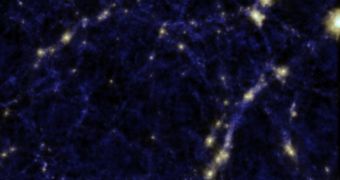A group of astronomers with the University of Western Australia node at the International Center for Radio Astronomy Research (ICRAR) recently discovered a never-before-seen arrangement in galaxies that exist inside massive cosmic voids. These are areas of the Universe where very small numbers of galaxies and stars exist, as opposed to the densely-populated galactic clusters, superclusters, and walls.
While investigating cosmic voids as part of the Galaxy and Mass Assembly (GAMA) survey, scientists were able to determine that the small number of galaxies that do inhabit these open spaces are arranged in delicate, string-like formations, which can be interpreted as constituting the cosmic web.
Details of their research were published in the March 10 issue of the esteemed journal Monthly Notices of the Royal Astronomical Society. The paper argues that these string-like arrangements are very weird, considering that galaxies and stars usually clump up into clusters and nodes, which are connected to each other via long strings.
This type of organized structure is what experts refer to as the cosmic web. Within any web, there are numerous empty spaces, and this is exactly what cosmic voids represent in this analogy. Some experts believe that the filaments in the cosmic web are determined by the flow of dark matter through the Universe. Due to gravitational interactions, galaxies and other structures fly along this flow.
UWA expert and research leader Dr. Mehmet Alpaslan says that astronomers have been trying to understand the few galaxies that exist in voids for years. While this goal remains elusive, this study brings more mysteries to the table. “We found small strings composed of just a few galaxies penetrating into the voids, a completely new type of structure that we’ve called ‘tendrils’,” Alpaslan says.
This discovery was made possible by GAMA observations conducted with the Anglo-Australian Telescope (AAT) in New South Wales, Australia. “Our new catalog has looked deeper into space and mapped each patch of sky up to ten times to make sure it’s as thorough as possible,” adds ICRAR investigator and UWA scientist Dr. Aaron Robotham.
What makes these tendrils so bizarre is the fact that they occupy regions of space that were previously thought to be entirely empty. “This means that voids might be much smaller than we previously thought, and that galaxies that were previously thought to be in a void might just be part of a tendril,” Alpaslan goes on to say.
The only way to figure out the exact nature of these structures is to conduct additional surveys of the night sky and analyze more of them. Data collected in this manner could then be used to rethink our understanding of cosmic voids and filaments and to determine how and why these tendrils penetrate empty spaces, instead of flowing along the cosmic web like all their counterparts.

 14 DAY TRIAL //
14 DAY TRIAL //